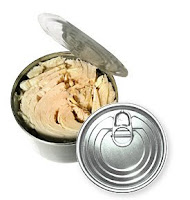 It may surprise you to learn that not all canned tuna is created equally.
It may surprise you to learn that not all canned tuna is created equally.First up: packed in water or oil?
Water is preferrable – for two reasons.
It results in less calories (60 calories per 2 ounce serving, rather than 110 or 120) and, since water and oil don't mix, the Omega-3 fatty acids present in tuna are not lost when water is drained.
The two more important issues surrounding canned tuna are sodium and mercury levels.
A standard 6 ounce can of tuna provides 750 - 850 milligrams of sodium (approximately a third of a day's needs) -- quite a bit for its low calorie contribution (roughly 150, if canned in water).
Look for low-sodium varieties that slash sodium by half, like Starkist's "low sodium tuna".
You will barely tell the difference, especially if you are eating canned tuna as part of a salad or sandwich.
Albacore tuna -- the white, meatier, less fishy tasting of the bunch -- happens to be one of the largest fish.
Therefore, its mercury content is approximately 3 times higher than that of smaller fish -- mainly skipjack -- used for chunk light varieties.
Some companies, like King of the Sea, sell authentically low-mercury -- chunk light is "lower mercury"-- tuna . The secret? Using yellowfin tuna!
Here's a tidbit that surprises many people.
Those of you with a milk protein (casein) allergy must read canned tuna labels carefully, since some of them are processed by adding hydrolyzed casein!
Lastly, be mindful of what you're putting on your tuna. If it's a few tablespoons of mayo, it's time to do some modifying.
I find, for instance, that hummus -- especially a red pepper variety -- is a wonderfully tasty replacement for mayonnaise when making tuna salad.





1 comment:
Thank you!!!
:)
-from a canned tuna consumer (hehe)
Post a Comment